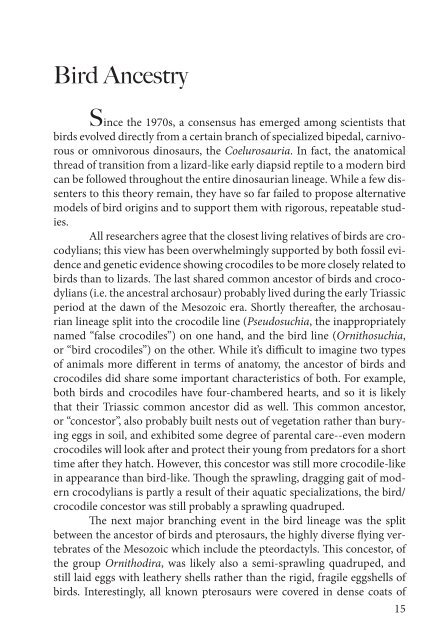You also want an ePaper? Increase the reach of your titles
YUMPU automatically turns print PDFs into web optimized ePapers that Google loves.
Bird Ancestry<br />
Since the 1970s, a consensus has emerged among scientists that<br />
<strong>birds</strong> evolved directly from a certain branch of specialized bipedal, carnivorous<br />
or omnivorous <strong>dinosaurs</strong>, the Coelurosauria. In fact, the ana<strong>to</strong>mical<br />
thread of transition from a lizard-like early diapsid reptile <strong>to</strong> a modern bird<br />
can be followed throughout the entire dinosaurian lineage. While a few dissenters<br />
<strong>to</strong> this theory remain, they have so far failed <strong>to</strong> propose alternative<br />
models of bird origins <strong>and</strong> <strong>to</strong> support them with rigorous, repeatable studies.<br />
All researchers agree that the closest living relatives of <strong>birds</strong> are crocodylians;<br />
this view has been overwhelmingly supported by both fossil evidence<br />
<strong>and</strong> genetic evidence showing crocodiles <strong>to</strong> be more closely related <strong>to</strong><br />
<strong>birds</strong> than <strong>to</strong> lizards. The last shared common ances<strong>to</strong>r of <strong>birds</strong> <strong>and</strong> crocodylians<br />
(i.e. the ancestral archosaur) probably lived during the early Triassic<br />
period at the dawn of the Mesozoic era. Shortly thereafter, the archosaurian<br />
lineage split in<strong>to</strong> the crocodile line (Pseudosuchia, the inappropriately<br />
named “false crocodiles”) on one h<strong>and</strong>, <strong>and</strong> the bird line (Ornithosuchia,<br />
or “bird crocodiles”) on the <strong>other</strong>. While it’s difficult <strong>to</strong> imagine two types<br />
of animals more different in terms of ana<strong>to</strong>my, the ances<strong>to</strong>r of <strong>birds</strong> <strong>and</strong><br />
crocodiles did share some important characteristics of both. For example,<br />
both <strong>birds</strong> <strong>and</strong> crocodiles have four-chambered hearts, <strong>and</strong> so it is likely<br />
that their Triassic common ances<strong>to</strong>r did as well. This common ances<strong>to</strong>r,<br />
or “conces<strong>to</strong>r”, also probably built nests out of vegetation rather than burying<br />
eggs in soil, <strong>and</strong> exhibited some degree of parental care--even modern<br />
crocodiles will look after <strong>and</strong> protect their young from preda<strong>to</strong>rs for a short<br />
time after they hatch. However, this conces<strong>to</strong>r was still more crocodile-like<br />
in appearance than bird-like. Though the sprawling, dragging gait of modern<br />
crocodylians is partly a result of their aquatic specializations, the bird/<br />
crocodile conces<strong>to</strong>r was still probably a sprawling quadruped.<br />
The next major branching event in the bird lineage was the split<br />
between the ances<strong>to</strong>r of <strong>birds</strong> <strong>and</strong> pterosaurs, the highly diverse flying vertebrates<br />
of the Mesozoic which include the pteordactyls. This conces<strong>to</strong>r, of<br />
the group Ornithodira, was likely also a semi-sprawling quadruped, <strong>and</strong><br />
still laid eggs with leathery shells rather than the rigid, fragile eggshells of<br />
<strong>birds</strong>. Interestingly, all known pterosaurs were covered in dense coats of<br />
15



